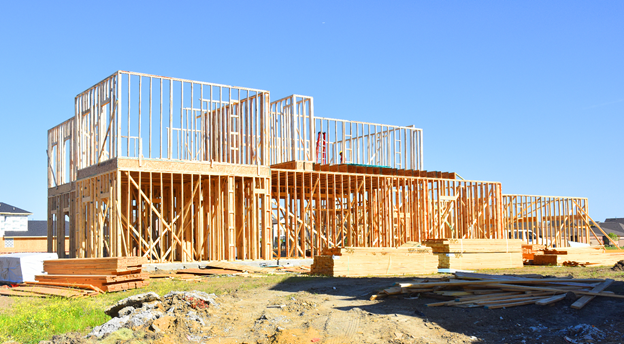The housing market has enjoyed an incredible run. Low inventory levels and a mass migration from urban cities to the suburbs led to double-digit increases in home prices.
Homebuilders are scrambling to meet the intense consumer demand. Unfortunately, supply chain issues made the process a little more difficult.
Now, prices are no longer climbing higher which means sellers are not as enthusiastic about listing their houses. Buyers paused and are reconsidering purchase decisions as mortgage rates have doubled from 3% to 6% in less than a year. The 30-year fixed mortgage rate hit 6.28% earlier this week!
Macro concerns are trumping operational success for the homebuilders. This has led to steady selling pressure in 2022.
Two major players in the group stepped into the earnings confessional this week. Would a solid round of results arrest some of the downward pressure on these stocks?

Lennar Corp (LEN)
Lennar reports Q2 (May) earnings of $4.69 per share, 74 cents better than analyst expectations of $3.95. Revenues increased 30% from the prior year to $8.36 billion which outpaced street expectations.
Deliveries rose 14% y/y to 16,549, above the high end of guidance provided at the start of the quarter. New orders rose 4% to 17,792 while the dollar value of these orders was up 20% from the prior-year period. Backlog rose 16% with the dollar value soaring 30% y/y to $14.7 billion.
Gross margins were 29.5% compared to 26% in the prior-year period and expectations of 28.5%.
The homebuilder stated that, in the current environment, attempts at guidance are merely guesses. This explains the wider-than-normal delivery outlook.
Lennar expects deliveries to be in the range of 17,000-18,500 in Q3 (Aug) compared to a historical range of approximately 300. Q3 EPS is projected to be in the range of $4.55-5.45.
Gross margins forecasts run between 28.5-29.5% compared to expectations of 28.5%.
LEN left its prior full-year delivery outlook unchanged at approximately 68,000. It refrained from providing full-year outlooks on traditional metrics like new orders and average sales price.
Lennar provided some cautionary comments on the state of the housing market. Sales slowed in certain markets while housing prices stalled nationwide. New orders, traffic, sales, and cancellations all worsened in June due to a rapid spike in mortgage rates and negative macro headwinds. Lennar said it expects costs to rise in the back half of the year, particularly lumber prices. This is occurring during a seasonable slowdown. It is offering incentives on mortgage buydowns and price reductions to offset some of the recent declines.
The company noted that there remains a significant housing shortage in the country, particularly workforce houses. Demand has softened but cancellation rates and completed, unsold inventory levels remain low on a historical basis.
The company continues to make progress in its land-light strategy which it debuted in early 2020. LEN is able to free up cash by controlling land instead of owning it. It is using part of this additional free cash flow to use for share buybacks. It repurchased $320 million worth of shares or nearly 2% of its market cap in the quarter.
Lennar’s net debt-to-cap ratio is 17% compared to the group average of 29% according to Wedbush. The company has nearly $4 billion in a credit facility and cash liquidity. It plans to redeem $575 million in debt this November and has no maturities in 2023.
The balance sheet and delivery outlook suggest LEN is well-positioned for a more volatile housing market in the next 6-12 months.
Shares of LEN are down 40% YTD. The stock is cheap as it trades at 4x forward earnings and 0.96x book value.
The dividend yield sits at 2.22%, hardly eye-popping given the recent run in rates but it does provide some income.
The stock is trying to find support at the $65 level but it may be difficult for shares to stem the downward momentum if we see housing data succumb to higher rates and a possible decline in employment data as the Fed tries to tame inflation by weakening wage growth.
Investors would be better served to stay patient and wait for weaker jobs number before entering a position. If we see LEN shares hold steady in the face of weaker employment figures then that could suggest the sellers have been cleaned out and a bottoming pattern can start to form.
LEN’s balance sheet would make this a top play in the group.
K.B. Homes (KBH)
K.B. Homes (KBH) reported Q2 (May) earnings of $2.32 per share, 29 cents better than street expectations. Revenues increased 19.4% to $1.72 billion, outpacing the $1.66 billion consensus. The company pre-released several operating metrics on June 7.
The top and bottom-line beat was a welcome rebound after a surprising miss in the first quarter,
Homes delivered were essentially even from the prior year at 3,469. Average selling prices rose 21% y/y to a whopping $494,300. Ending backlog value rose 43% to $6.12 billion, slightly lower than expected. Backlog of 12,331 rose 23% from the prior-year period.
Homebuilding operating income grew 62% to $264 million. Margins increased 410 basis points to 15.4%.
FY22 Housing Revenue guidance was in the range of $7.3-7.5 billion, a tighter range than the prior outlook of $7.2-7.6 billion. Average selling prices are expected to be $500,000, at the high end of the prior guidance for $490,000-500.000.
Full-year housing gross profit margins are projected to come in the range of 25.6-26.2%, up slightly from prior guidance of 25.5-26.3%, assuming no inventory-related charges.
KBH has locked in most of its $6.1 billion backlog for FY22 which suggests its guidance is safe.
The homebuilder is not seeing customers trading down to smaller floor plans in June, nor are they spending less at design centers. They are not seeing a move to adjustable-rate mortgages despite lower nominal rates than fixed rates.
KBH announced it is slowing land acquisitions until sales conditions improve. It has ample land to maintain community growth through FY 24. This should free up cash for either debt reduction and/or shareholder repurchases. KBH stated it would remain strategic in its capital allocation decisions to maximize returns in a difficult environment.
Customer trends, supply chain improvement, and backlog locks would be bullish data points for the industry. However, sentiment suggests that investors are questioning the upbeat tone.
The stock trades at a 30% discount to its Q2 book value and a 37% discount to FY22 earnings estimates according to Credit Suisse. It sits at a minuscule 2.24x forward earnings and offers some income value with dividend yields at 2.29%.
Shares broke below key support at the $30 level last week. We saw it stabilize at $25 and it is enjoying a small bounce following its latest round of results.
There is no denying the stock is cheap but we would want to see it re-establish ground above $30 before getting comfortable.
Just like LEN, we would prefer to see the group digest some potential poor economic data points before putting money to work in the name.



